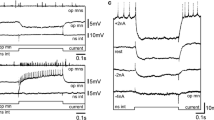Summary
Intracellular records from three muscles in the gastropod mollusc Helisoma trivolvis are described and correlated with extracellular electromyograms and tension recordings. These data are then used to formulate criteria for the identification of motoneurons in the central nervous system.
-
1.
Individual muscle fibers in the three muscles studied were small in diameter (less than 10 μ), arranged in a parallel fashion, and heavily invested by connective tissue (Fig. 1).
-
2.
Initial identification of neurons in the central nervous system as excitatory motoneurons to particular muscles was based on a number of criteria: a) each action potential in that neuron was followed by an extracellular electromyogram response in the muscle of relatively constant latency; b) in the case of the posterior jugalis, the action potentials of the motoneuron accounted for all extracellularly recorded activity in the muscle during normal function (Fig. 3) ; and c) procion yellow dye injections and antidromic stimulation showed that the axons of such neurons leave the CNS in nerve trunks shown by electrical stimulation to contain the excitatory axons to specific muscles.
-
3.
A single basic pattern of muscle innervation, which was comparable to the vertebrate motor unit, was observed. The posterior jugalis appears to be controlled by a single motoneuron whereas the columellar muscle appears to be under the control of a number of motoneurons. Intracellular recordings gave no indication of multiple innervation of individual muscle fibers. High gain intracellular records revealed miniature excitatory junctional potentials but inhibitory junctional potentials were never observed in any of the muscles studied.
Similar content being viewed by others
References
Carriker, M. R.: Observations on the functioning of the alimentary system of the snail Lymnaea stagnalis appressa Say. Biol. Bull. 91, 88–111 (1946).
—: Morphology of the alimentary system of the snail Lymnaea stagnalis appressa Say. Trans. Wisconsin Acad. Sci. Arts Letters 38, 1–88 (1947).
Hill, R. B., Greenberg, M. J., Irisawa, H., Nomura, H.: Electromechanical coupling in a molluscan muscle, the radula protractor of Busycon canaliculatum. J. exp. Zool. 174, 331–348 (1970).
Mellon, De F.: Junctional physiology and motor nerve distribution in the fast adductor muscle of the scallop. Science, 160, 1018–1020 (1968).
— Prior, D. J.: Components of a response programme involving inhibitory and excitatory reflexes in the surf clam. J. exp. Biol. 53, 711–725 (1970).
Sato, M., Tamasige, M., Ozeki, M.: Electrical activity of the retractor pharynx muscle of the snail. Jap. J. Physiol. 10, 85–98 (1960).
Stretton, A. O. W., Kravitz, E. A.: Neuronal geometry: determination with a technique of intracellular dye injection. Science, 162, 32 (1968).
Twarog, B. M.: Factors influencing contraction and catch in Mytilus smooth muscle. J. Physiol. (Lond.) 192, 847–856 (1967).
Author information
Authors and Affiliations
Additional information
We thank Dr. DeForest Mellon for his helpful comments on this manuscript. This research was supported by PHS grant 1 R01 NS09696-01 (awarded to S.B.K.) and, in part, by University Development Grant GU 2591 from NSF.
Rights and permissions
About this article
Cite this article
Kater, S.B., Heyer, C. & Hegmann, J.P. Neuromuscular transmission in the gastropod mollusc Helisoma trivolvis: Identification of motoneurons. Z. vergl. Physiologie 74, 127–139 (1971). https://doi.org/10.1007/BF00339927
Received:
Issue Date:
DOI: https://doi.org/10.1007/BF00339927




